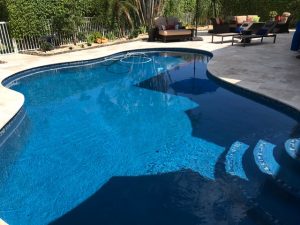Choosing Between Travertine and Brick Pavers For Your Pool Deck
 Numerous options exist for serviceable pool decking: Natural stone, wood deck, poured concrete, eurotile, concrete pavers, brick, tile, composite materials, and even synthetic grass. Among the many options available for pool decking, stone and brick both enjoy a reputation for high value and lasting durability.
Numerous options exist for serviceable pool decking: Natural stone, wood deck, poured concrete, eurotile, concrete pavers, brick, tile, composite materials, and even synthetic grass. Among the many options available for pool decking, stone and brick both enjoy a reputation for high value and lasting durability.
While in the end, the choice of material will be made probably purely by personal taste, it is important to become familiar with the advantages and disadvantages of each of those more popular materials.
In South Florida, the most popular options are by far Brick Pavers and Travertine. We can evaluate both by their function and durability, lasting good looks, safety, upkeep and maintenance requirements, and, above all, cost! But perhaps how they look in your landscape might be the main reason why you’d pick one or the other. Aesthetics play a huge part here, and should not be forgotten.
Let’s then consider the benefits and drawbacks of two popular choices: Travertine and Brick. Travertine is a specific type of natural stone that is popular for pool decks for good reason. Even though travertine is typically imported, it is readily available, cost-effective, versatile and adaptable. Brick also is used for distinctive pools because of its ready availability and reasonable cost. Beyond those factors, though, each material has specific advantages, as well as a couple of drawbacks.
Here’s how they compare:
Travertine is a natural stone, while brick is a manufactured product, but each is an inherently natural material well-suited for outdoor use. Sun and water are not a concern with either one, and both are relatively easy to maintain. Each is available in thick or thin versions. Brick pavers, while typically the same surface dimensions as standard bricks, vary between 1.25 and 2 inches in thickness. Travertine pavers are generally a similar thickness, and they can be smooth with square edges or tumbled to appear more “natural” and rustic. Travertine tiles, on the other hand, are typically only about 1/2 inch thick, and are available in multiple sizes, including mosaics and large squares or rectangles.
Both travertine and brick allow for great creativity of installation. Colors and sizes are often mixed to create unique designs patterns, and both may be installed on sand or over a concrete slab.
Relative Advantages of Travertine Pavers
Travertine, like marble and granite, is deemed a luxury material and adds style and flair in unique ways. The stone is easy to handle, relatively easy to install, available in multiple sizes, and easy to cut as needed for custom installations. Even though it has an overall grain, or pattern, it appears relatively uniform in hue over a large area.
Travertine is typically installed with ungrouted joints, allowing for easy repair or replacement of individual tiles as necessary.
Other great qualities include:
– Long-term durability,
– Porosity, allowing for good drainage and quick drying,
– Resistance to damage from temperature variations,
– Eco-friendly qualities,
– Smooth and cool to walk on, even in high temperatures,
– No efflorescence,
– Travertine will not harbor pests or attract insects,
– Resistant to freeze-thaw cycles,
Benefits of Brick Pavers
Brick pavers of different hues are easily combined for interesting effects, and the wide variety of brick colors allows owners to play light against dark, or to complement and contrast decking with architectural elements, pool design and landscaping. An overall herringbone or Flemish bond pattern is classic and visually interesting. Custom designs are easy for a professional installer. Finally, because brick is such a common landscape element, brick paver pool decks blend nicely with surrounding architecture and landscape elements. Savvy homeowners will repeat the theme with outdoor fireplaces, retaining walls, garden paths and planting bed borders.
Reasons to choose brick include:
– Stain resistance and ease of maintenance,
– Ready availability,
– Permanent color in a wide variety of hues,
– Quality consistency,
– Textured slip resistance,
– Design flexibility.
Some Disadvantages of Travertine
– A travertine deck must be sealed initially, and periodically thereafter,
– Some liquids may etch or stain the surface,
– Weight may be a problem unless the deck area is thoroughly stabilized,
– Available in limited colors other than neutral tones.
– Travertine can crack and chip with hard use.
Now The Disadvantages of Brick Pavers
– Settling and uneven surfaces can be a problem,
– If installed on the sand, weeds can grow between the brick,
– Moss, mold, fungus and efflorescence can be problematic in wet, humid areas,
– Brick gets hot, and brick surfaces can be rough.
The Final Verdict: Travertine vs Brick Pavers: Which one is The Right Choice?
No matter what your pool design entails or how generous your budget, the choice of decking remains an individual one. There are no rights or wrongs. The best way to ensure that your pool will be attractive and usable for many years to come is to weigh the pros and cons of every element and judge the effect of each material in the overall design.
All Seal Exteriors has been in the business of serving pool owners in South Florida for more than two decades. We are proud of our record of service to pool owners in Pompano Beach, Fort Lauderdale, Boca Raton and other nearby communities. Gathering around a pool is a unique way of life for us all, and we rely on our expertise to help our clients enjoy that life to the fullest.





